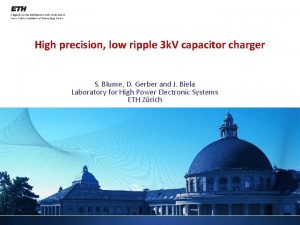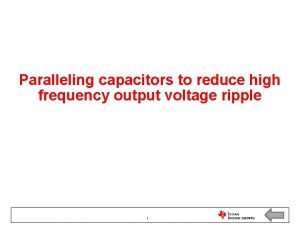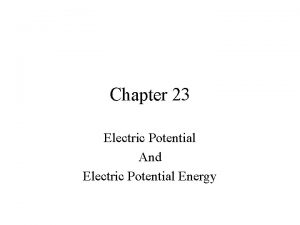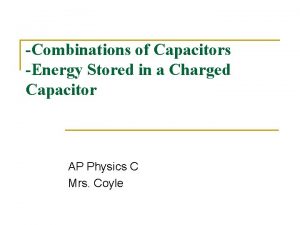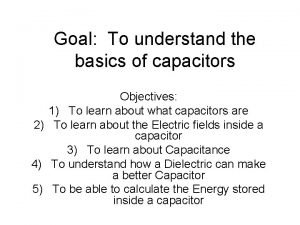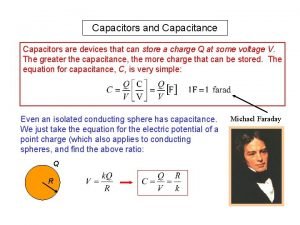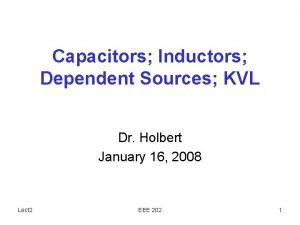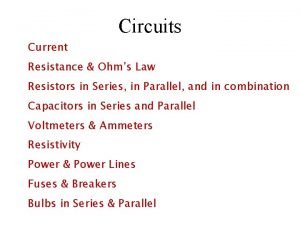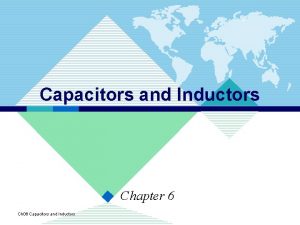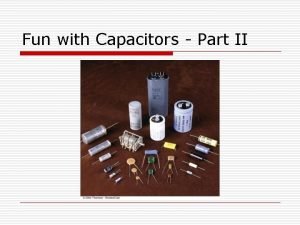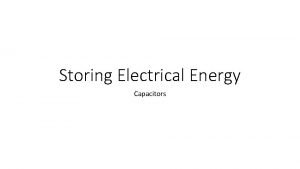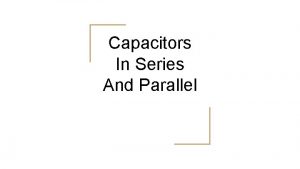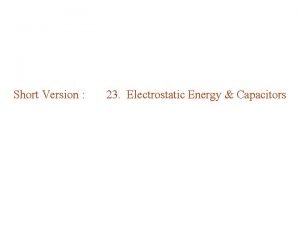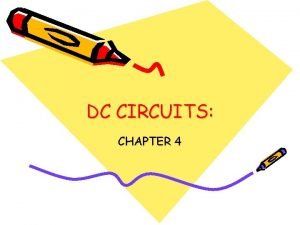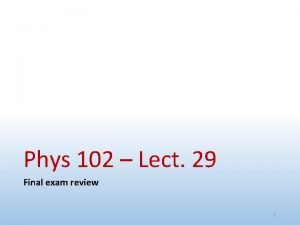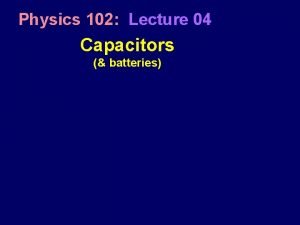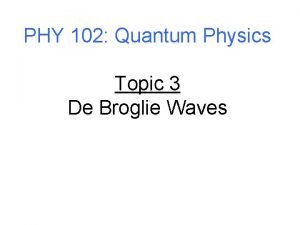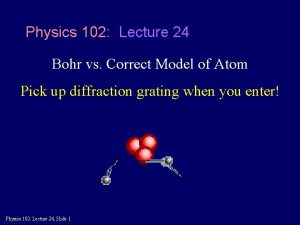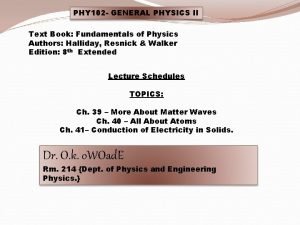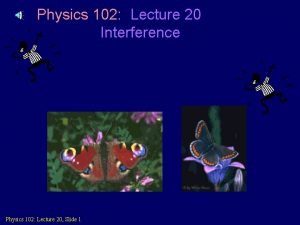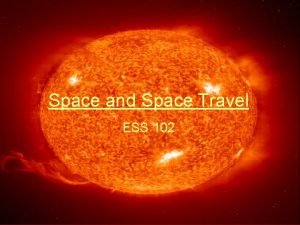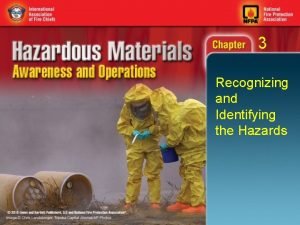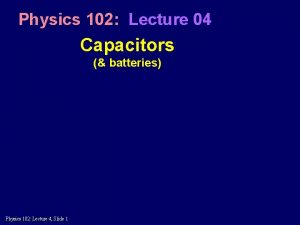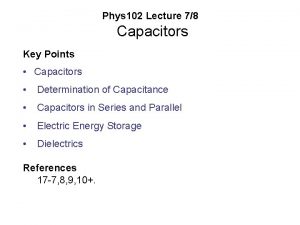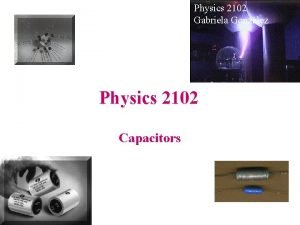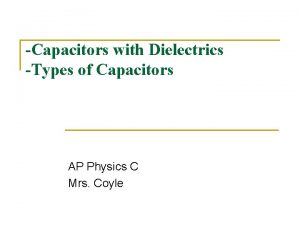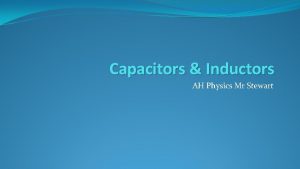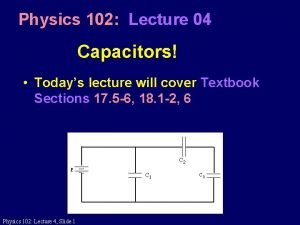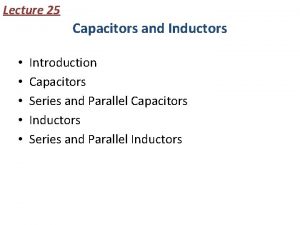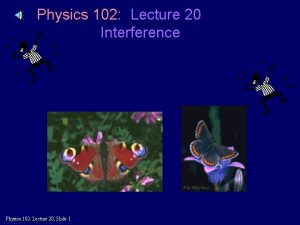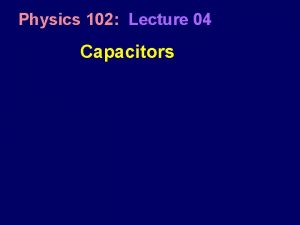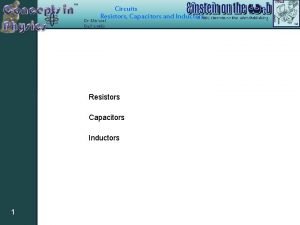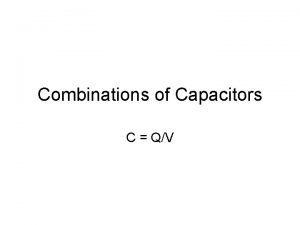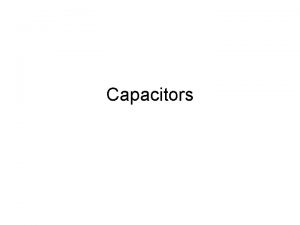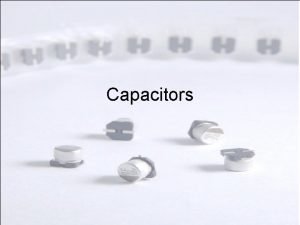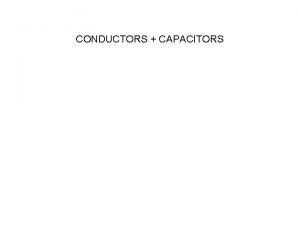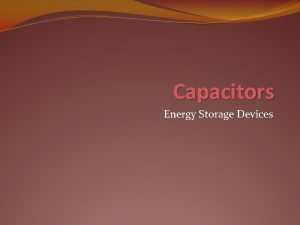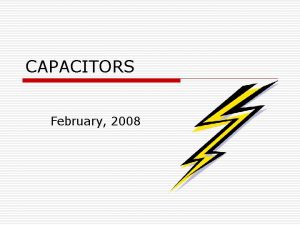Physics 102 Lecture 04 Capacitors Physics 102 Lecture




































- Slides: 36

Physics 102: Lecture 04 Capacitors Physics 102: Lecture 4, Slide 1

Recall from last lecture…. . Electric Fields, Electric Potential Physics 102: Lecture 4, Slide 2

Comparison: Electric Potential Energy vs. Electric Potential q A B DVAB : the difference in electric potential between points B and A DUAB : the change in electric potential energy of a charge q when moved from A to B DUAB = q DVAB Physics 102: Lecture 4, Slide 3

Physics 102: Lecture 4, Slide 4

Electric Potential: Summary • E field lines point from higher to lower potential • For positive charges, going from higher to lower potential is “downhill” • For a battery, the (+) terminal is at a higher potential than the (–) terminal Positive charges tend to go “downhill”, from + to Negative charges go in the opposite direction, from - to + DUAB = q DVAB Physics 102: Lecture 4, Slide 5

Important Special Case Uniform Electric Field + - + - + - Two large parallel conducting plates of area A +Q on one plate -Q on other plate Then E is uniform between the two plates: E=4 k. Q/A zero everywhere else This result is independent of plate separation This is call a parallel plate capacitor Physics 102: Lecture 4, Slide 6

Parallel Plate Capacitor: Potential Difference Charge Q on plates V =VA – VB = +E 0 d E=E 0 + - + +A B + + d - Charge 2 Q on plates V =VA – VB = +2 E 0 d + E=2 E 0 + + +A + + d B - Potential difference is proportional to charge: Double Q Double V E 0=4 k. Q/A Physics 102: Lecture 4, Slide 7

Physics 102: Lecture 4, Slide 8

Capacitance: The ability to store separated charge C Q/V • Any pair conductors separated by a small distance. (e. g. two metal plates) • Capacitor stores separated charge Q=CV – Positive Q on one conductor, negative Q on other – Net charge is zero + • Stores Energy U =(½) Q V Units: 1 Coulomb/Volt = 1 Farad (F) Physics 102: Lecture 4, Slide 9 + + E - + - d

Why Separate Charge? • • Camera Flash Defibrillator—see ex. 17. 12 in text AC → DC Tuners – Radio – Cell phones Analogy to a waterfall Physics 102: Lecture 4, Slide 10

Capacitance Practice How much charge is on a 0. 9 F capacitor which has a potential difference of 200 Volts? How much energy is stored in this capacitor? Physics 102: Lecture 4, Slide 11

Physics 102: Lecture 4, Slide 12

Capacitance of Parallel Plate Capacitor V = Ed E=4 k. Q/A V (Between two large plates) So: V = 4 k. Qd/A Recall: C Q/V So: C = A/(4 kd) Define: 0=1/(4 k)=8. 85 x 10 -12 C 2/Nm 2 C = 0 A/d Parallel plate capacitor Physics 102: Lecture 4, Slide 13 A +E d -A

Parallel Plate Capacitor C = 0 A/d Calculate the capacitance of a parallel plate capacitor made from two large square metal sheets 1. 3 m on a side, separated by 0. 1 m. A A d Physics 102: Lecture 4, Slide 14

Dielectric • Placing a dielectric between the plates increases the capacitance. Dielectric constant (k > 1) C = k C 0 Capacitance with dielectric Physics 102: Lecture 4, Slide 15 Capacitance without dielectric

Physics 102: Lecture 4, Slide 16

ACT: Parallel Plates -q pull - + - d +q + pull + A parallel plate capacitor given a charge q. The plates are then pulled a small distance further apart. What happens to the charge q on each plate of the capacitor? 1) Increases 2) Constant 3) Decreases Remember charge is real/physical. There is no place for the charges to go. Physics 102: Lecture 4, Slide 17

-q Preflight 4. 1 pull - + - d +q + pull + - A parallel plate capacitor given a charge q. The plates are then pulled a small distance further apart. Which of the following apply to the situation after the plates have been moved? 1)The capacitance increases 2)The electric field increases 3)The voltage between the plates increases Physics 102: Lecture 4, Slide 18 True False

ACT/Preflight 4. 1 -q pull - + - d + +q pull + A parallel plate capacitor given a charge q. The plates are then pulled a small distance further apart. Which of the following apply to the situation after the plates have been moved? The energy stored in the capacitor A) increases Physics 102: Lecture 4, Slide 19 B) constant C) decreases

Physics 102: Lecture 4, Slide 20

ACT/Preflight 4. 2 Two identical parallel plate capacitors are shown in end-view in A) of the figure. Each has a capacitance of C. A) B) If the two are joined as in (B) of the figure, forming a single capacitor, what is the final capacitance? 1) 2 C 2) C 3) C/2 Physics 102: Lecture 4, Slide 21

Voltage in Circuits • Elements are connected by wires. • Any connected region of wire has the same potential. • The potential difference across an element is the element’s “voltage. ” Vwire 1= 0 V C 1 VC 1= 5 -0 V= 5 V Physics 102: Lecture 4, Slide 22 Vwire 2= 5 V Vwire 3= 12 V C 2 VC 2= 12 -5 V= 7 V Vwire 4= 15 V C 3 VC 3= 15 -12 V= 3 V

Capacitors in Parallel • Both ends connected together by wire • Same voltage: V 1 = V 2 = Veq • Add Areas: Ceq = C 1+C 2 remember C= 0 A/d • Share Charge: Qeq = Q 1+Q 2 15 V C 1 C 2 10 V Physics 102: Lecture 4, Slide 23 10 V 15 V Ceq 10 V

Physics 102: Lecture 4, Slide 24

Parallel Practice A 4 m. F capacitor and 6 m. F capacitor are connected in parallel and charged to 5 volts. Calculate Ceq, and the charge on each capacitor. Ceq = C 4+C 6 = 4 m. F+6 m. F = 10 m. F Q 4 = C 4 V 4 = (4 m. F)(5 V) = 20 m. C Q 6 = C 6 V 6 = (6 m. F)(5 V) = 30 m. C Qeq = Ceq Veq = (10 m. F)(5 V) = 50 m. C = Q 4+Q 6 5 V 5 V C 4 C 6 0 V 0 V Physics 102: Lecture 4, Slide 25 V=5 V 5 V Ceq 0 V

Capacitors in Series • Connected end-to-end with NO other exits • Same Charge: Q 1 = Q 2 = Qeq • Add d: • Share Voltage: V 1+V 2=Veq +Q -Q + ++ --++ + + ++ - + -+ + + Physics 102: Lecture 4, Slide 26 + C 1 +Q + Ceq C 2 -Q -

Series Practice A 4 m. F capacitor and 6 m. F capacitor are connected in series and charged to 5 volts. Calculate Ceq, and the charge on the 4 m. F capacitor. Q = CV +Q -Q 5 V + + - Physics 102: Lecture 4, Slide 27 C 4 +Q -Q C 6 0 V 5 V + - Ceq 0 V

Physics 102: Lecture 4, Slide 28

Comparison: Series vs. Parallel Series Parallel • Can follow a wire from one element to the other with no branches in between. C 1 C 2 Physics 102: Lecture 4, Slide 29 • Can find a loop of wire containing both elements but no others (may have branches). C 1 C 2

Electromotive Force • Battery + - – Maintains constant potential difference V – Does NOT produce or supply charges, just “pushes” them. Physics 102: Lecture 4, Slide 30

Preflight 4. 4 A circuit consists of three initially uncharged capacitors C 1, C 2, and C 3, which are then connected to a battery of emf E. The capacitors obtain charges q 1, q 2, q 3, and have voltages across their plates V 1, V 2, and V 3. Which of these are true? 1) q 1 = q 2 C 2 2) q 2 = q 3 3) V 2 = V 3 4) E = V 1 5) V 1 < V 2 6) Ceq > C 1 Physics 102: Lecture 4, Slide 31 E +q 2 + - V 1 +q 1 -q 1 C 1 -q 2 V 2 +q 3 V 3 -q 3 C 3

Physics 102: Lecture 4, Slide 32

ACT/Preflight 4. 4: Which is true? A circuit consists of three initially uncharged capacitors C 1, C 2, and C 3, which are then connected to a battery of emf E. The capacitors obtain charges q 1, q 2, q 3, and have voltages across their plates V 1, V 2, and V 3. C 2 E +q 2 + - V 1 +q 1 -q 1 C 1 -q 2 V 2 +q 3 V 3 -q 3 1) q 1 = q 2 Not necessarily C and C are NOT in series. 1 2 2) q 2 = q 3 Yes! C 2 and C 3 are in series. Physics 102: Lecture 4, Slide 33 C 3

ACT/Preflight 4. 4: Which is true? A circuit consists of three initially uncharged capacitors C 1, C 2, and C 3, which are then connected to a battery of emf E. The capacitors obtain charges q 1, q 2, q 3, and have voltages across their plates V 1, V 2, and V 3. C 2 10 V E 7 V? ? +q 2 + V 1 - +q 1 C 1 -q 2 V 2 -q 1 0 V 1) V 2 = V 3 Not necessarily, only if C 1 = C 2 2) E = V 1 Yes! Both ends are connected by wires Physics 102: Lecture 4, Slide 34 +q 3 V 3 -q 3 C 3

ACT/Preflight 4. 4: Which is true? A circuit consists of three initially uncharged capacitors C 1, C 2, and C 3, which are then connected to a battery of emf E. The capacitors obtain charges q 1, q 2, q 3, and have voltages across their plates V 1, V 2, and V 3. C 2 10 V E +q 2 + V 1 - +q 1 C 1 7 V? ? -q 2 V 2 -q 1 0 V 1) V 1 < V 2 Nope, V 1 > V 2. (E. g. V 1 = 10 -0, V 2 =10 -7) 2) Ceq > C 1 Yes! C 1 is in parallel with C 23 Physics 102: Lecture 4, Slide 35 +q 3 V 3 -q 3 C 3

Recap of Today’s Lecture • • • Capacitance C = Q/V Parallel Plate: C = 0 A/d Capacitors in parallel: Ceq = C 1+C 2 Capacitors in series: Ceq = 1/(1/C 1+1/C 2) Batteries provide fixed potential difference Physics 102: Lecture 4, Slide 36
 Flat ppr
Flat ppr Paralleling capacitors
Paralleling capacitors Energy stored in capacitors
Energy stored in capacitors Voltage across capacitors in series
Voltage across capacitors in series The basics of capacitors
The basics of capacitors Energy in a capacitor
Energy in a capacitor “zero sum” voltage loop rule
“zero sum” voltage loop rule Capacitors in series formula
Capacitors in series formula I = c dv/dt example
I = c dv/dt example Fun with capacitors
Fun with capacitors Energy in capacitors
Energy in capacitors Voltage across capacitors in series
Voltage across capacitors in series Energy density in electrostatic field
Energy density in electrostatic field Introduction of capacitor and inductor
Introduction of capacitor and inductor Physics 102 final exam
Physics 102 final exam Physics 102
Physics 102 Electric potential lecture
Electric potential lecture Physics 102
Physics 102 Phys 102 uiuc
Phys 102 uiuc Physics 102
Physics 102 Physics 102
Physics 102 Physics 102
Physics 102 Physics 102
Physics 102 01:640:244 lecture notes - lecture 15: plat, idah, farad
01:640:244 lecture notes - lecture 15: plat, idah, farad Physics 111 lecture notes
Physics 111 lecture notes Waves pdf
Waves pdf Physics 101 lecture notes pdf
Physics 101 lecture notes pdf Atmospheric physics lecture notes
Atmospheric physics lecture notes Phy101 lecture 1
Phy101 lecture 1 Physics 101 lecture notes pdf
Physics 101 lecture notes pdf University physics with modern physics fifteenth edition
University physics with modern physics fifteenth edition Physics ia ideas sports
Physics ia ideas sports Why does it happen
Why does it happen Ess 102
Ess 102 Find x
Find x Cse 102
Cse 102 Mc 338 tanker
Mc 338 tanker
